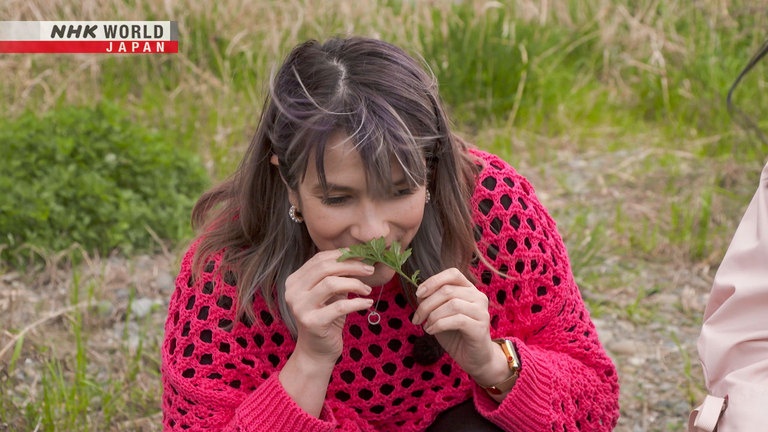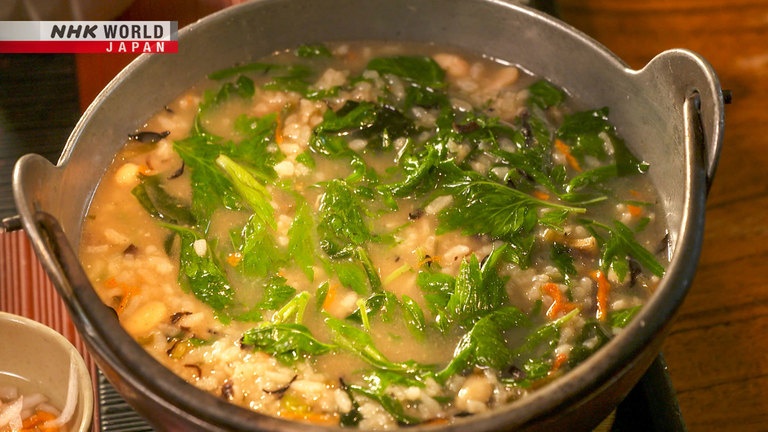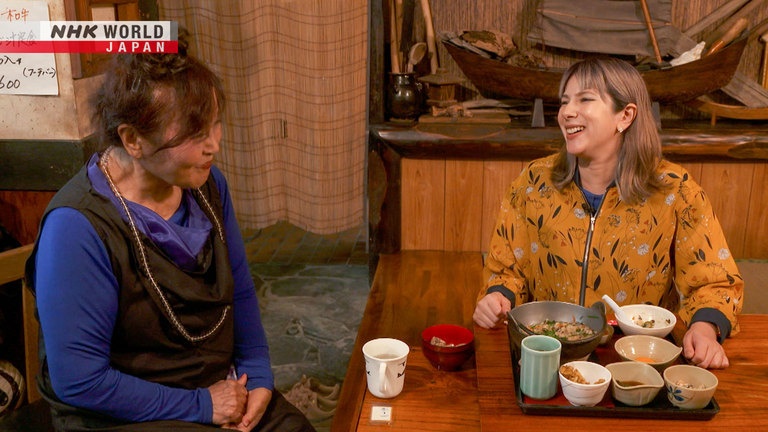YOMOGI
Yomogi speckles the fields and roadside greenery of the spring season. Used in various dishes, from savory to sweet, the plant is also used to produce a substance called moxa for healing methods that date back over 1,000 years. The "queen of the herbs" is even mentioned in classical poetry. With health benefits thought to promote longevity, it's played a key role in Okinawan tradition. Dig in to discover more about this overlooked weed! (Reporter: GOW)




Transcript
Tokyo: this world-class metropolis is a veritable gourmet wonderland.
Discover the stories behind the ingredients that make this city so delicious - so "oishii."
In the fields and roadside greenery of spring, you'll come across a special plant - yomogi.
In Japan, it's considered an edible weed.
It's used in all kinds of dishes, from savory to sweet.
"Oishii!"
Because it's so common, yomogi is often overlooked.
But it has wonderful health benefits.
Appearing in Japanese poetry from over a thousand years ago, yomogi is clearly more than just a weed.
It's a cultural icon.
Is this it?
I think this is yomogi!
Dig in to find out more about this precious green.
Trails to Oishii Tokyo.
Hi, everyone! My name is Gow, and in this episode, we are featuring yomogi.
Yomogi is best in the spring, and now Japan is in full bloom,
so I'm very excited to what kind of cuisines we are going to encounter.
We're going to start out from Toyosu Market, so please follow me.
We arrive at Tokyo's Toyosu Market.
It's Japan's largest wholesale market.
Our reporter Gow visits to check out a shop selling Japanese sweets.
This is where I was looking for.
Hi.
Wow, there's a lot of people.
Hello.
The shop dates back to 1898.
They began over 120 years ago when the fish market was located in Tokyo's Nihonbashi area.
For both buyers and traders, it's a popular place to stop and relax.
Owner Fukuda Tetsuya has some yomogi sweets for Gow to try.
This is "kusa-mochi."
"Kusa-mochi."
Introducing their specialty sweet...
With the fresh aroma and green color of yomogi leaves, it's a symbol of the spring season.
It's very, very beautiful. Look at the greenery.
And inside of it there's a lot of "anko."
Good smell!
It's very greeny.
Like an earthy, herbal aroma.
Very nice.
Here we go.
Very, very tasty. Wow.
It's not mint, it's not basil.
But it has a very minty kind of aroma inside your mouth.
It's a little greeny, earthy, and it's also very refreshing.
- Very delicious.
- Thank you.
It goes great with "anko."
It's very leafy.
I can feel the fiber in it.
It's possible to use yomogi powder,
but this is made with actual leaves.
He uses yomogi leaves that're handpicked soon after sprouting.
After the veins are removed, leaves are boiled in water, and scum is removed.
It's mixed with steamed "joshinko" rice flour and pounded.
Using fresh yomogi gives it a fibrous texture and leafy aroma.
After pounding, it's wrapped around "anko."
They work late into the night to have freshly-made "kusa-mochi" ready the next day.
During peak season, in spring, they make up to 1,000 a day.
They used to use larger leaf chunks to bring out more flavor.
But in recent years, they've decided to chop them up more.
Previously, we made them with longer fibers,
with a leafier texture.
But people started to complain about that.
New customers didn't find it as appetizing.
Sadly, retaining the leaf's natural qualities
wasn't getting the reaction we hoped for.
Initially, you kept a leafier texture on purpose?
That's right.
Elders used to cut local yomogi
and bring the leaves home to mix with mochi.
That's how "kusa-mochi" came to be.
When customers tell us our "kusa-mochi" is good,
I say, well, almost as good as grandma's!
You said people picked their own yomogi.
Is it that easy to find?
Yomogi's a weed, so it can
be seen around Tokyo too.
It basically grows anywhere,
so it's easy to find.
I see.
Are you saying I should go
into people's back yards?
Digging up weeds in Tokyo?
Let's see what Gow can find!
She heads to the Tama River, an hour drive from Toyosu Market.
The river flows between Tokyo and Kanagawa, and out into Tokyo Bay.
Along the water, you'll find many grassy areas and parks.
Nice to meet you. Are you Non?
Yes, I'm Non. Nice to meet you.
I work with wild grass year-round.
Non is part of a nature conservation group.
As a specialist, she leads up to 100 wild plant observations every year.
We'll look at the nature at our feet.
Should I watch where I step?
Actually, that's a great question!
Some want you to step on them.
Come again?
These, for example.
Here.
That's fleawort.
When you step on them,
seeds attach to your shoes.
That's how they spread,
so they're meant to be stepped on.
I see!
She says you'll find some 100 varieties of wild plants on just an hour walk down the Tama River.
How do you find yomogi in all of that?
- Yomogi have jagged leaves.
- Jagged leaves?
That's their characteristic.
Yomogi suppress the growth of other plants.
They push them away.
Right. Fewer plants grow
in areas with lots of yomogi.
You'll see spots of only yomogi.
- That makes them easier to find.
- Exactly.
Let's check here.
Perhaps you can see them.
- Here?
- Correct.
- Here and there?
- Yes.
- And here?
- Yep.
They form little islands.
Yomogi stems spread horizontally underground, allowing the herbs to grow in little colonies.
Yomogi is a perennial herb in the chrysanthemum family.
The resemblance lies in the leaves.
Rub the leaves to release their aroma.
Yep. Smells like yomogi.
- Smells fresh.
- Very refreshing.
What gives it this scent?
You'll see it doesn't have many bugs on it.
It's said that the plants release an aroma
to keep them away.
Yomogi is a true survivor.
One secret weapon is found on the lighter undersides of its leaves.
Gow takes a closer look.
What's this?
Wow.
It's like spider webs.
It looks like spider webs.
But it's not, right?
It grows tiny hairs.
She finds a network of tiny white hairs...
Non will tell us what they're for.
The hairs are said to retain moisture.
That's so they can grow in dry areas.
What a powerful plant.
I can feel the power of the yomogi.
Very tough.
The hairs contain a flammable substance that can burn for a long time.
The hairs are collected, dried, and processed to create something called moxa.
In East Asian medicine, moxa is used for therapy called "moxibustion."
Moxa is heated near or directly on the skin to offer therapeutic effects, relieving unwanted symptoms.
It took off in Japan after being introduced from China.
Yomogi is mentioned in a "waka" poem written around the time moxa was introduced in Japan over 1,000 years ago.
'How can I tell her
How fierce my love for her is?
'Will she understand
That the love I feel for her
Burns like "sashimo-gusa?"'
This romantic poem by a nobleman mentions "sashimo-gusa," what yomogi was called at the time.
It's about a love that burns
everlasting like wild yomogi.
Love stories and poems usually have
roses and lilies, but in Japan it's yomogi?
Yomogi as well, yes.
Yomogi comes up quite a bit.
Very interesting.
There's a lot of passion under
that cool, refreshing facade.
In Japan, it's been used in many ways for ages.
It's like the queen of herbs.
I hope its popularity only grows.
Absolutely.
I'd like to know more about
how it's used, and how it's eaten!
It's eaten in a lot of areas, like in Okinawa.
- Okinawa?
- Yeah, it's big there.
I'll have to go there!
Please do.
Next stop: Okinawa!
Nago, Okinawa is 1,500 kilometers south of Tokyo.
The city lies on the north side of Okinawa's main island.
It's home to a variety of sub-tropical vegetation.
It's also a great place to experience Okinawa's unique yomogi food culture.
Gow begins at a local market.
Oh, I can already hear some Okinawan music.
Oh, looks like there's a lot of fruits and vegetables are being selled here.
Hi.
Goya. Bitter gourds.
Okinawa's very famous for goya.
It's cucumber. Bitter cucumber.
What are these?
Pig's feet.
So this is how it's sold.
Wait...
Is this it?
I think this is yomogi.
Excuse me.
- Is this yomogi?
- Yes.
That's a lot for 250 yen.
It says "fu-chiba" yomogi.
What's that?
"Fu-chiba" is the word for yomogi
in the Okinawan dialect.
I see.
Many people like it because
it's considered a power food.
In Okinawa, yomogi is available all year round - not only in spring.
On the first day of school,
on the 100th day of a child's life,
or when building a new house,
yomogi is eaten to celebrate many things.
I had no idea.
In Okinawa, it's customary to eat
goat soup with yomogi.
Goat soup, huh.
With yomogi inside.
Gow's ready to try some of that goat soup!
Maybe one of Yamashiro's customers can cook some up.
Hello.
What a lovely place.
Thanks for waiting.
Today's yomogi delivery.
Looks good, as usual.
This Japanese-style bar and restaurant, or "izakaya," is close to the market.
It's a popular place to eat goat.
Prep begins early in the morning.
Goats live well in hot climates, so they've been a popular meat source in Okinawa for ages.
They're both tasty and nutritious.
We eat most of the goat,
even its bones and internal organs.
We joke that the only thing
we don't eat is its voice.
The meat cooks for four hours, then some blood is stirred in.
It's seasoned with a local spirit called "awamori," salt and "katsuobushi" bonito flakes.
Scum is skimmed off the top, then it's ready.
It's served with a handful of yomogi leaves.
Yomogi from Okinawa is less bitter with a milder aroma, so it doesn't need processing.
I like it.
Very delicious.
It was nothing like I thought.
I thought that the taste would be a little more gamey and a little more meaty and maybe even stinky, but no.
I think the yomogi helps it be a little more clear.
- Yomogi gives the soup a milder flavor.
- Right.
"Oishii."
I like it.
Good to hear.
Goat fat isn't easy to digest.
Yomogi helps with that.
That's how the custom started.
I bet this would be great
with noodles or rice too.
Yeah, we eat what's called goat soba.
We also eat this dish with rice.
I see.
At the end of the night.
After a night of drinking.
Either steak or goat soup.
The bitter compound in yomogi combats fatigue in the body's organs -
perfect after a night on the town.
Outside of festive occasions, the soup has a special place at the bar counter.
Gow heads to another restaurant serving local dishes.
Yomogi is seen dancing in the wind out front.
It's picked fresh every morning.
Yomogi grows fine on its own, so it doesn't need tending to.
I don't take the lower leaves,
only clean ones from the top.
We're picky about using only the soft leaves.
Goat soup isn't the only way to enjoy yomogi.
This porridge is a mix of rice, seaweed and carrots cooked in pork broth.
This serves one person.
I'll put in some lard that we
prepare ourselves at this restaurant.
Add yomogi, and let it cook for another minute or so.
We call this "boro-boro jushi."
In Okinawa, this is what you eat when you have a cold or feel a bit under the weather.
The smell, the smell of yomogi, it's taking over.
The leaf itself is very good.
I didn't think that it would be this good.
I'm enjoying it.
As I chew, as I bite the leaves, I think the medication - like taste comes out,
but it's also surrounded with a green kind of substance,
and I think that it goes very good with the rice and all the ingredients that are in here.
As I eat, I can feel it
giving me energy and strength.
This is the key to longevity in Okinawa.
Please live a long life.
- This is why Okinawans live so long?
- That's right.
Toguchi Ayako is 88 years young.
The Okinawan word for yomogi, "fu-chiba," means "healing herb."
Understandably, it's used for all sorts of occasions.
A good example of a healthy local favorite is this squid ink soup.
We use yomogi in many ways
because it's good for our bodies.
It turns our food into a life medicine.
It's great that an affordable food can be
such an immense source of power.
Okinawa has placed importance in medicinal cuisine for centuries, with yomogi at the forefront.
Gow is now back in Tokyo.
She heads to a French restaurant in Ginza, a leading shopping district.
Chef Kato Junichi uses carefully selected Japanese ingredients in his contemporary French recipes.
This foie gras terrine with Shizuoka green tea is one of his most famous dishes.
Kato says a spring course meal would be incomplete without yomogi.
A yomogi dessert.
Wow, it's a beautiful masterpiece of art.
Yomogi is a very Japanese ingredient,
so this presentation is Zen-inspired.
Is yomogi common in French cuisine?
You don't really see it outside of Japan.
The plant doesn't have a set name like in Japan.
It's referred to loosely as a wild mountain herb.
A yomogi and yoghurt sorbet is placed over lemon custard cream.
This yomogi bread is crushed and sprinkled on top.
The platter is his canvas.
Yoghurt frozen with liquid nitrogen resembles snow dusting the ground in early spring.
This darker powder, representing sunlight, is made from caramelized yoghurt.
Dried cherry blossoms are the final touch.
Unique!
Yomogi flavor is very, very lively inside your mouth,
but it also has a hint of yoghurt in it, and I think that it's a perfect combination.
What does yomogi mean to you?
It has unending potential.
It has a flavor unique to Japan.
The impact and flavor are different
from other herbs like basil and mint.
It transports you to a calm, dim forest.
I think yomogi is a fascinating herb.
For powerful yomogi, who knows what lies ahead.
Through this journey I have discovered that yomogi is not just delicious,
the scent is like a forest and it's one of a kind.
Not only does it have medical effects, but you can use it in so many ways.
That's why Japanese people have loved and treasured it throughout the years.
I do truly believe that yomogi is the queen of herbs.
In Tokyo, every ingredient has its own story.